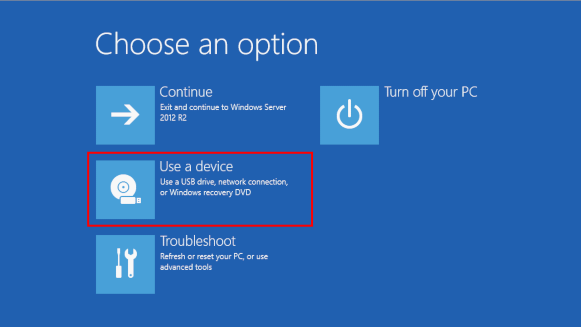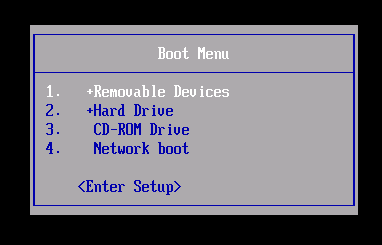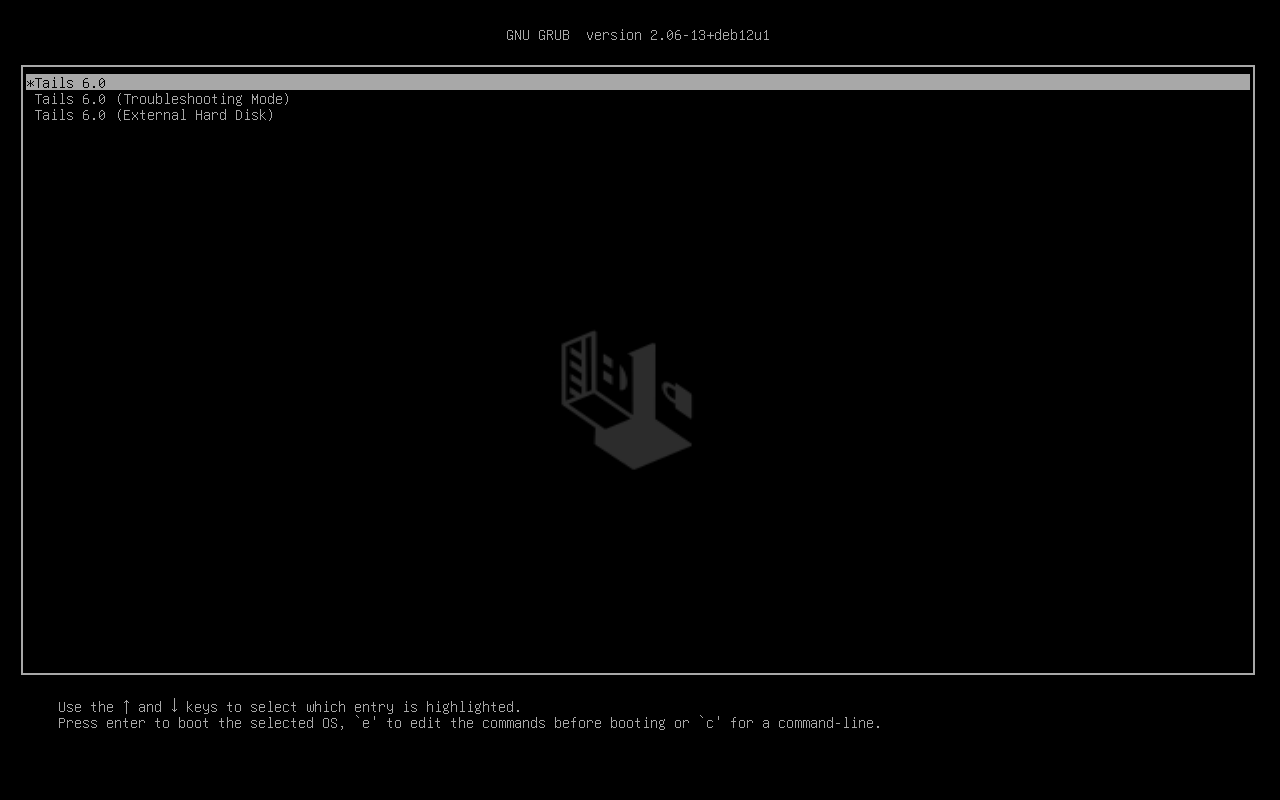- doc
- first steps
- start
- Starting Tails on PC
This page describes the basic and advanced techniques to start Tails from a USB stick on PC.
Starting from Windows 8 or 10
From Windows or the sign-in screen of Windows:
-
Make sure that you have installed Tails using either:
Click on the button.
Press and hold the Shift key while you choose Power ▸ Restart.
In the Choose an option screen, choose Use a device.

If the Choose an option screen or the Use a device option don't appear, refer to the instructions on starting Tails using the Boot Menu key.
In the Use a device screen, choose Boot Menu.
Windows shuts down, the computer restarts, and a Boot Menu appears.
Plug in your Tails USB stick shortly after choosing Boot Menu and while Windows is shutting down.
If your Windows has no Boot Menu option available, make sure that your intermediary Tails USB stick is plugged in and choose your USB stick directly in the list of devices.
In the future, we We recommend that you only plug in your Tails USB stick while Windows is shutting down. Otherwise, a virus in Windows could infect your Tails USB stick and break its security.
Such an attack is possible in theory but very unlikely in practice. We don't know of any virus capable of infecting Tails. See our warning on plugging Tails in untrusted systems.
The Boot Menu is a list of possible devices to start from. The following screenshot is an example of a Boot Menu:

In the Boot Menu, select your USB stick and press Enter.
If the computer starts on Tails, the Boot Loader appears and Tails starts automatically after 4 seconds.
The Troubleshooting Mode entry disables some features of the Linux kernel and might work better on some computers. You can try this option if you think you are experiencing hardware compatibility errors while starting Tails.
The External Hard Disk entry makes it possible to start from an external hard disk and some problematic USB sticks.
If the Boot Loader appears, you can follow our instructions on the Welcome Screen.
Starting with the Boot Menu key
Most computers do not start automatically on the Tails USB stick, but you can press a Boot Menu key to display a list of possible devices to start from.
If Windows 8 or 10 is also installed on the computer, you can refer instead to the instructions on starting Tails from Windows 8 or 10. Starting Tails from Windows is easier than using the Boot Menu key.
The following screenshot is an example of a Boot Menu:

This animation summarizes how to use the Boot Menu key to start on the USB stick:
The following instructions explain in detail how to use the Boot Menu key to start on the USB stick:
-
Make sure that you have installed Tails using either:
-
Shut down the computer while leaving the USB stick plugged in.
Shut down the computer and plug in the Tails USB stick.
Shut down the computer.
Plug in the other Tails USB stick that you want to install upgrade from.
Unplug your Tails USB stick while leaving the intermediary USB stick plugged in.
-
Identify the possible Boot Menu keys for the computer depending on the computer manufacturer in the following list:
Manufacturer Key Acer F12, F9, F2, Esc Apple Option Asus Esc Clevo F7 Dell F12 Fujitsu F12, Esc HP F9 Huawei F12 Intel F10 Lenovo F12, Novo MSI F11 Samsung Esc, F12, F2 Sony F11, Esc, F10 Toshiba F12 Others… F12, Esc On many computers, a message is displayed very briefly when switching on that also explains how to get to the Boot Menu or edit the BIOS settings.
-
Switch on the computer.
Immediately press several times the first possible Boot Menu key identified in step 2.
-
If the computer starts on another operating system or returns an error message, shut down the computer again and repeat step 3 for all the possible Boot Menu keys identified in step 2.
If a Boot Menu with a list of devices appears, select your USB stick and press Enter.
If the computer starts on Tails, the Boot Loader appears and Tails starts automatically after 4 seconds.
If the Boot Loader appears, you can follow our instructions on the Welcome Screen.
Starting on Tails automatically
To start on Tails automatically when your Tails USB stick is plugged in:
Open the BIOS or UEFI settings of the computer.
To learn how to edit the BIOS or UEFI settings, search for the user manual of the computer on the support website of the manufacturer.
Edit the Boot Order. You might see an entry for Removable devices or USB media. Move this entry to the top of the list to force the computer to start from the USB stick before starting from the internal hard disk.
Restart the computer.
Troubleshooting Tails not starting at all
Use this section if the computer does not start from the USB stick and the Boot Loader does not display:
Verify your Tails USB stick
Wait 2–3 minutes and try again. Some USB sticks need some rest after installing.
Try all other USB ports on the computer. Some USB ports cannot be used to start from.
Make sure that you have installed Tails using either:
Make sure that you have verified your download of Tails.
Make sure that you have verified your download.
-
Try to install again on the same USB stick.
Try to install again on the same USB stick.
Try to install again on the same USB stick.
Try to install again on the same USB stick.
Try to install again on the same USB stick.
Try to install again on the same USB stick.
Try to install again on the same USB stick.
Try to install again on the same USB stick.
Try to install again on the same USB stick.
Try to install again on the same USB stick.
Try to install again on the same USB stick.
Try to install again on the same USB stick.
Try to install on a different USB stick.
Try to use the same USB stick to start on a different computer.
If you get the following error message in Windows:
The disc image file is corrupted.
Then, you have to install Tails using balenaEtcher.
Check our list of known issues
Similar problems might have been reported already for your computer model in our list of known issues about Tails not starting at all.
Edit the BIOS or UEFI settings (advanced users)
To learn how to edit the BIOS or UEFI settings, search for the user manual of the computer on the support website of the manufacturer.
Take note of the changes that you apply to the BIOS or UEFI settings. That way, you can revert the changes if they prevent the computer from starting on its usual operating system.
In the BIOS or UEFI settings, try to apply the following changes:
Make sure that the Boot Menu key is enabled, in your BIOS or UEFI options. This option might be called Boot Device List or something similar, depending on the computer.
Edit the Boot Order. You might see an entry for Removable devices or USB media. Move this entry to the top of the list to force the computer to start from the USB stick before starting from the internal hard disk.
Disable Fast Boot.
Enable CSM Boot.
Enable Legacy Boot, in addition to UEFI. The computer might not start anymore on its regular operating system if you disable UEFI completely or if you only enable Legacy boot.
Try to upgrade the BIOS or UEFI. To do so, refer to the support website of the computer manufacturer.
Troubleshooting Tails not starting after the Boot Loader
Use this section if the Boot Loader appears but not the Welcome Screen when you start Tails.
Verify your Tails USB stick
Wait 2–3 minutes and try again. Some USB sticks need some rest after installing.
Try all other USB ports on the computer. Some USB ports cannot be used to start from.
Make sure that you have installed Tails using either:
Make sure that you have verified your download of Tails.
Make sure that you have verified your download.
-
Try to install again on the same USB stick.
Try to install again on the same USB stick.
Try to install again on the same USB stick.
Try to install again on the same USB stick.
Try to install again on the same USB stick.
Try to install again on the same USB stick.
Try to install again on the same USB stick.
Try to install again on the same USB stick.
Try to install again on the same USB stick.
Try to install again on the same USB stick.
Try to install again on the same USB stick.
Try to install again on the same USB stick.
Try to install on a different USB stick.
Try to use the same USB stick to start on a different computer.
Try the Troubleshooting Mode entry
In the Boot Loader, choose the Troubleshooting Mode entry, which works better on some computers.
Try the External Hard Disk entry
In the Boot Loader, choose the External Hard Disk entry, if it is available. Some USB sticks need this entry in order to start Tails.
Check our list of known issues
If the computer displays the error message Error starting GDM with your graphics card, refer to our list of known issues with graphics cards.
Otherwise, refer to our list of known issues about Tails not starting entirely. It might contain workarounds for your computer model.

